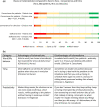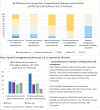Telemedicine in rheumatology: a mixed methods study exploring acceptability, preferences and experiences among patients and clinicians
- PMID: 34698822
- PMCID: PMC8689882
- DOI: 10.1093/rheumatology/keab796
Telemedicine in rheumatology: a mixed methods study exploring acceptability, preferences and experiences among patients and clinicians
Abstract
Objectives: The Covid-19 pandemic necessitated a rapid global transition towards telemedicine; yet much remains unknown about telemedicine's acceptability and safety in rheumatology. To help address this gap and inform practice, this study investigated rheumatology patient and clinician experiences and views of telemedicine.
Methods: Sequential mixed methodology combined analysis of surveys and in-depth interviews. Between and within-group differences in views of telemedicine were examined for patients and clinicians using t-tests.
Results: Surveys (patients n = 1340, clinicians n = 111) and interviews (patients n = 31, clinicians n = 29) were completed between April 2021 and July 2021. The majority of patients were from the UK (96%) and had inflammatory arthritis (32%) or lupus (32%). Patients and clinicians rated telemedicine as worse than face-to-face consultations in almost all categories, although >60% found it more convenient. Building trusting medical relationships and assessment accuracy were great concerns (93% of clinicians and 86% of patients rated telemedicine as worse than face-to-face for assessment accuracy). Telemedicine was perceived to have increased misdiagnoses, inequalities and barriers to accessing care. Participants reported highly disparate telemedicine delivery and responsiveness from primary and secondary care. Although rheumatology clinicians highlighted the importance of a quick response to flaring patients, only 55% of patients were confident that their rheumatology department would respond within 48 hours.
Conclusion: Findings indicate a preference for face-to-face consultations. Some negative experiences may be due to the pandemic rather than telemedicine specifically, although the risk of greater diagnostic inaccuracies using telemedicine is unlikely to be fully resolved. Training, choice, careful patient selection, and further consultation with clinicians and patients is required to increase telemedicine's acceptability and safety.
Trial registration: This telemedicine study is part of a pre-registered longitudinal multi-stage trial, the LISTEN study (ISRCTN-14966097), with later Covid-related additions registered in March 2021, including a pre-registered statistical analysis plan.
Keywords: digital technology in medicine; mixed-methods; pandemic; patient–physician interactions; rare autoimmune rheumatic diseases; rheumatology; telemedicine.
© The Author(s) 2021. Published by Oxford University Press on behalf of the British Society for Rheumatology.
Figures



Comment in
-
Telemedicine: a solution for everyone?Nat Rev Rheumatol. 2022 Apr;18(4):187-188. doi: 10.1038/s41584-022-00763-x. Nat Rev Rheumatol. 2022. PMID: 35181777 Free PMC article.
Similar articles
-
Will 'the feeling of abandonment' remain? Persisting impacts of the COVID-19 pandemic on rheumatology patients and clinicians.Rheumatology (Oxford). 2022 Aug 30;61(9):3723-3736. doi: 10.1093/rheumatology/keab937. Rheumatology (Oxford). 2022. PMID: 34995345 Free PMC article. Clinical Trial.
-
LoVE in a time of CoVID: Clinician and patient experience using telemedicine for chronic epilepsy management.Epilepsy Behav. 2021 Feb;115:107675. doi: 10.1016/j.yebeh.2020.107675. Epub 2020 Dec 17. Epilepsy Behav. 2021. PMID: 33342712 Free PMC article.
-
Benefits and challenges of telemedicine for heart failure consultations: a qualitative study.BMC Health Serv Res. 2023 Aug 10;23(1):847. doi: 10.1186/s12913-023-09872-z. BMC Health Serv Res. 2023. PMID: 37563576 Free PMC article.
-
Intersecting factors of disadvantage and discrimination and their effect on daily life during the coronavirus pandemic: the CICADA-ME mixed-methods study.Health Soc Care Deliv Res. 2025 Feb;13(2):1-185. doi: 10.3310/KYTF4381. Health Soc Care Deliv Res. 2025. PMID: 39949202
-
Telemedicine in Vascular Surgery During COVID-19 Pandemic: A Systematic Review and Narrative Synthesis.Ann Vasc Surg. 2023 Jul;93:166-173. doi: 10.1016/j.avsg.2023.03.023. Epub 2023 Apr 1. Ann Vasc Surg. 2023. PMID: 37011724 Free PMC article.
Cited by
-
Perception of Telemedicine and Remote Learning Following the COVID-19 Pandemic: A Health Education England Survey of London Obstetrics and Gynaecology Trainees.Adv Med Educ Pract. 2024 Dec 17;15:1231-1242. doi: 10.2147/AMEP.S469745. eCollection 2024. Adv Med Educ Pract. 2024. PMID: 39717223 Free PMC article.
-
Digital Health for Equitable Rheumatic Care: Integrating Real-World Experiences to Guide Policy Pathways.Healthcare (Basel). 2025 Feb 18;13(4):438. doi: 10.3390/healthcare13040438. Healthcare (Basel). 2025. PMID: 39997313 Free PMC article. Review.
-
Telemedicine: a solution for everyone?Nat Rev Rheumatol. 2022 Apr;18(4):187-188. doi: 10.1038/s41584-022-00763-x. Nat Rev Rheumatol. 2022. PMID: 35181777 Free PMC article.
-
Acceptability of, and preferences for, remote consulting during COVID-19 among older patients with two common long-term musculoskeletal conditions: findings from three qualitative studies and recommendations for practice.BMC Musculoskelet Disord. 2022 Apr 2;23(1):312. doi: 10.1186/s12891-022-05273-1. BMC Musculoskelet Disord. 2022. PMID: 35366845 Free PMC article.
-
The COVID-19 Pandemic Heightens Interest in Cytokine Storm Disease and Advances in Machine Learning Diagnosis, Telemedicine, and Primordial Prevention of Rheumatic Diseases.Eur J Rheumatol. 2024 Nov 28;11(4):410-417. doi: 10.5152/eurjrheum.2024.23059. Eur J Rheumatol. 2024. PMID: 39651898 Free PMC article. Review.
References
Publication types
MeSH terms
Associated data
Grants and funding
LinkOut - more resources
Full Text Sources
Medical
Miscellaneous

